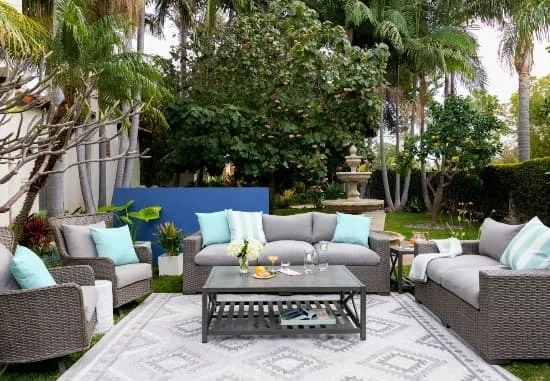Construction projects, regardless of scale, can have unforeseen consequences on your surroundings, especially on the often overlooked patio furniture. Dust, debris, heavy equipment movement, and accidental spillages can lead to lasting damage. It’s crucial to know the protective measures to shield your furniture, ensuring it remains pristine throughout the construction phase.
Relocate, If Possible
If you have a construction project looming, the best precautionary measure is relocating your patio furniture to a safer location. This could be a garage, basement, or even inside your home if space permits. By doing so, you entirely eliminate the risk of any construction-related damage.
For heavier items or those integrated into the patio design, such as built-in benches, consider creating a buffer zone around them. A temporary plywood wall or fence can help keep direct threats at bay.
The Indispensable Role of Patio Covers
In circumstances where relocating isn’t feasible, patio covers come to the rescue. These covers, often made of durable fabrics, are designed to shield furniture from various elements. Here’s why using them during construction projects is beneficial:
- Dust and Debris: Construction projects are notorious for the dust and tiny debris they generate. Patio covers act as a first line of defense, preventing these particles from settling on your furniture surfaces.
- Spill Protection: Accidental spills of paint, solvents, or other construction materials can cause permanent stains. Covers provide a protective layer, ensuring any accidental spills don’t come in direct contact with the furniture.
- Physical Damage: Construction tools and equipment can inadvertently come into contact with furniture, leading to scratches, dents, or more severe damage. A robust patio cover can minimize this risk by providing a cushioned barrier.
Regular Cleaning is Key
Throughout the construction process, it’s wise to periodically check and clean your furniture, even if they are covered. This routine ensures that no harmful substances stay on for long durations, which could lead to more profound damage or staining. Use a gentle brush to dust off any accumulated particles and a damp cloth for more persistent spots.
Insurance and Documentation
Before embarking on any construction project, it’s prudent to check your home insurance policy to understand the coverage regarding any potential damage to patio furniture. It may also be beneficial to photograph your furniture before the project starts.
Here’s a simple data table illustrating why documentation is essential:
| Reason for Documentation | Benefits |
| Proof of Current Condition | Validates any post-construction damage claims. |
| Inventory Management | Helps ensure all items are accounted for post-construction. |
| Assessment of Value | Provides a reference for any potential compensation or repairs. |
Minimize Construction Traffic Near the Patio
The more you can restrict construction-related foot traffic around your patio area, the better. Often, the inadvertent dragging of tools, materials, or heavy boots can cause wear and tear to your patio and its furniture. By clearly marking out pathways for workers and ensuring they are aware of the furniture’s presence, you can prevent unnecessary damage. Furthermore, using barriers or temporary fencing can deter unplanned shortcuts across the patio area. Not only does this preserve the furniture, but it also ensures a safer work environment by clearly defining where construction activity should be concentrated.
Ventilation and Chemical Fumes
When thinking about furniture protection, it’s easy to focus solely on the physical threats and overlook the potential harm from airborne chemicals. Various construction projects, especially those involving paint, solvents, or sealants, release fumes that can settle on your patio furniture. Over time, these can degrade the quality of fabrics or tarnish metal finishes. If you’re aware that certain activities will produce fumes, ensure that your patio furniture is adequately covered or even temporarily relocated. Moreover, try to keep the area ventilated. Using fans to direct fumes away from furniture zones or opting for low-VOC products can mitigate potential harm. Remember, it’s not just about protecting the furniture’s appearance but also about maintaining a healthy environment in your outdoor space.
Conclusion
Your patio furniture is an investment, offering comfort and enhancing outdoor aesthetics. During construction projects, they face heightened risks. However, with proactive measures like relocation, the use of patio covers, regular cleaning, and thorough documentation, you can ensure they remain unscathed, ready to grace your revamped space once the project concludes.


